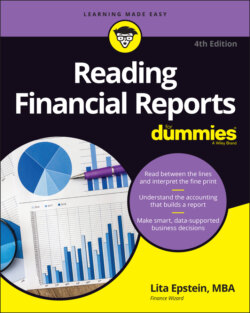Читать книгу Reading Financial Reports For Dummies - Lita Epstein - Страница 72
Why method matters
ОглавлениеThe accounting method a business uses can have a major impact on the total revenue it reports, as well as on the expenses it subtracts from the revenue to get the bottom line. Here's how:
Cash-basis accounting: Expenses and revenues aren't carefully matched on a month-to-month basis. The company doesn't recognize expenses until it actually pays the money, even if it incurs the expenses in previous months. Likewise, the business doesn't recognize the revenues it earned in previous months until it actually receives the cash. However, cash-basis accounting excels in tracking the actual cash available, as well as the cash going in and out of the business.
Accrual accounting: Expenses and revenue are matched, giving a company a better idea of how much it's spending to operate each month and how much profit it's making. The company records (or accrues) expenses in the month incurred, even if it doesn't pay out the cash until the next month. Likewise, the company records revenues in the month it completes the project or ships the product, even if the company hasn't yet received the cash from the customer.
The way a company records payment of payroll taxes, for example, differs with these two methods. In accrual accounting, each month the company sets aside the amount it expects to pay toward its quarterly tax bills for employee taxes using an accrual (a paper transaction in which no money changes hands). The entry goes into a tax liability account (an account for tracking tax payments that the company has made or must still make). If the company incurs $1,000 of tax liabilities in March, it enters that amount in the tax liability account even if it hasn't yet paid out the cash. That way, the expense is matched to the month in which it's incurred.
In cash accounting, the company doesn't record the liability until it actually pays the government the cash. Although it incurs tax expenses each month, a company using cash accounting shows a higher profit during two months every quarter, and possibly even shows a loss in the third month when the taxes are paid.
To see how these two methods can result in totally different financial statements, imagine that a carpenter contracts a job with a total cost to the customer of $2,000. The carpenter's expected expenses for the supplies, labor, and other necessities are $1,200, so their expected profit is $800. They contract the work on December 23, 2021, and complete the job on December 31, 2021, but they aren’t paid until January 3, 2022. The contractor takes no cash up front and instead agrees to be paid in full upon completion.
If the contractor uses the cash-basis accounting method, then because no cash changes hands, they don’t have to report any revenues from this transaction in 2021. But say the contractor lays out the cash for their expenses in 2021. In this case, their bottom line is $1,200 less, with no revenue to offset it, and their net profit (the amount of money their company earns, minus expenses) for the business in 2021 is lower. This scenario may not necessarily be bad if the contractor is trying to reduce their tax hit for 2021.
